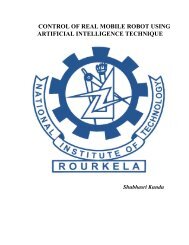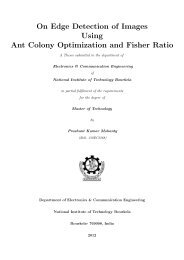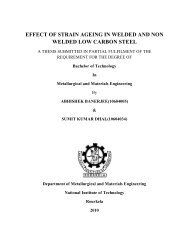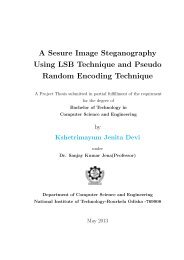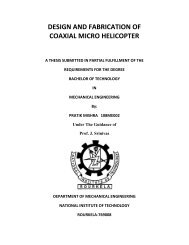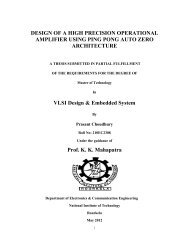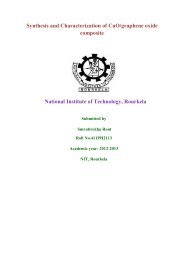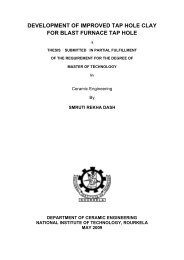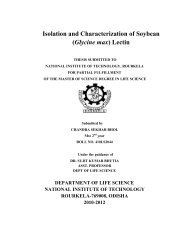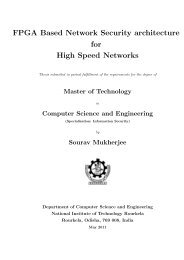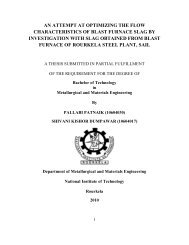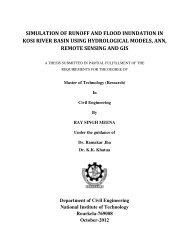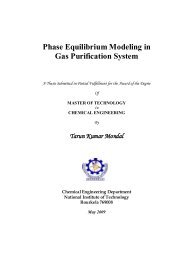analysis of transient heat conduction in different geometries - ethesis ...
analysis of transient heat conduction in different geometries - ethesis ...
analysis of transient heat conduction in different geometries - ethesis ...
Create successful ePaper yourself
Turn your PDF publications into a flip-book with our unique Google optimized e-Paper software.
error. In this case the approximate two-dimensional <strong>analysis</strong> is used to calculate the error, and a<br />
2D f<strong>in</strong>ite-difference solution <strong>of</strong> Fourier equation is used to validate the method.<br />
Sheng et al. [24] <strong>in</strong>vestigated the <strong>transient</strong> <strong>heat</strong> transfer <strong>in</strong> two-dimensional annular f<strong>in</strong>s <strong>of</strong><br />
various shapes with its base subjected to a <strong>heat</strong> flux vary<strong>in</strong>g as a s<strong>in</strong>usoidal time function. The<br />
<strong>transient</strong> temperature distribution <strong>of</strong> the annular f<strong>in</strong>s <strong>of</strong> various shapes are obta<strong>in</strong>ed as its base<br />
subjected to a <strong>heat</strong> flux vary<strong>in</strong>g as a s<strong>in</strong>usoidal time function by employ<strong>in</strong>g <strong>in</strong>verse Laplace<br />
transform by the Fourier series technique.<br />
Sahu et al. [25] depicted a two region <strong>conduction</strong>-controlled rewett<strong>in</strong>g model <strong>of</strong> hot vertical<br />
surfaces with <strong>in</strong>ternal <strong>heat</strong> generation and boundary <strong>heat</strong> flux subjected to a constant wet side<br />
<strong>heat</strong> transfer coefficient and negligible <strong>heat</strong> transfer from dry side by us<strong>in</strong>g the Heat Balance<br />
Integral Method. The HBIM yields the temperature field and quench front temperature as a<br />
function <strong>of</strong> various model parameters such as Peclet number, Biot number and <strong>in</strong>ternal <strong>heat</strong><br />
source parameter <strong>of</strong> the hot surface. The authors have also obta<strong>in</strong>ed the critical <strong>in</strong>ternal <strong>heat</strong><br />
source parameter by consider<strong>in</strong>g Peclet number equal to zero, which yields the m<strong>in</strong>imum <strong>in</strong>ternal<br />
<strong>heat</strong> source parameter to prevent the hot surface from be<strong>in</strong>g rewetted. The approximate method<br />
used, derive a unified relationship for a two-dimensional slab and tube with both <strong>in</strong>ternal <strong>heat</strong><br />
generation and boundary <strong>heat</strong> flux.<br />
Faruk Yigit [26] considered taken a two-dimensional <strong>heat</strong> <strong>conduction</strong> problem where a liquid<br />
becomes solidified by <strong>heat</strong> transfer to a s<strong>in</strong>usoidal mold <strong>of</strong> f<strong>in</strong>ite thickness. He has solved this<br />
problem by us<strong>in</strong>g l<strong>in</strong>ear perturbation method. The liquid perfectly wets the s<strong>in</strong>usoidal mold<br />
surface for the beg<strong>in</strong>n<strong>in</strong>g <strong>of</strong> solidification result<strong>in</strong>g <strong>in</strong> an undulation <strong>of</strong> the solidified shell<br />
thickness. The temperature <strong>of</strong> the outer surface <strong>of</strong> the mold is assumed to be constant. He has<br />
determ<strong>in</strong>ed the results <strong>of</strong> solid/melt mov<strong>in</strong>g <strong>in</strong>terface as a function <strong>of</strong> time and for the<br />
temperature distribution for the shell and mold. He has considered the problem with prescribed<br />
solid/melt boundary to determ<strong>in</strong>e surface temperature.<br />
Vrentas and Vrentas [27] proposed a method for obta<strong>in</strong><strong>in</strong>g analytical solutions to lam<strong>in</strong>ar flow<br />
thermal entrance region problems with axial <strong>conduction</strong> with the mixed type wall boundary<br />
conditions. They have used Green’s functions and the solution <strong>of</strong> a Fredholm <strong>in</strong>tegral equation to<br />
16



